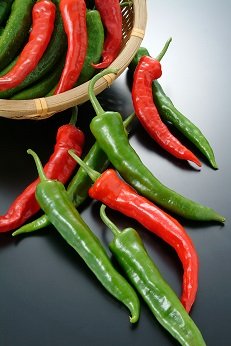Shimizumori Namba
| Registration Number | 105 |
|---|---|
| Name of the GI | Shimizumori Red Pepper, Shimizumori Green Pepper, Shimizumori Namba |
| Class | Vegetables/ Cereal grains/Pulses |
| Date of Protection | 2020/12/23 |
| Producing Area |
Aomori Prefecture
Hirosaki City, Hirakawa City, Nishimeya Village in Nakatsugaru County, Inakadate Village and Owani Town in Minamitsugaru County |
| Applicant - Name and Address | Zairai Tsugaru Shimizumori Namba Brand Management Research Society 61 Kamenoko-machi Hirosaki City, Aomori Prefecture |
Producing Area
Shimizumori Namba is a native variety of pepper called "Hirosaki Zairai Togarashi", that has been passed on since the Edo Period (1) around Hirosaki City, Aomori Prefecture. It is relatively large and long, and its shape is unique with a broad and high shoulder.
With low content of the pungent ingredient or Capsaicinoid, Shimizumori Namba has mild spiciness, slight sweetness, and a unique taste. Thus, it goes very well with other foods, and can be used widely as a seasoning.
For the production of Shimizumori Namba, "Hirosaki Zairai Togarashi" (native variety) is used as the cultivar.
At the seed production field designated in the producing area, the seeds are taken only from the healthy plants which show the characteristic shape of Shimizumori Namba. Thereafter, seedlings are raised in the dedicated field from the germinating seeds, to be used for cultivation.
The seed management is conducted by the Zairai Tsugaru Shimizumori Namba Brand Management Research Society that consists of producers, a university, local governments, and processors. In case it becomes difficult for the Research Society to maintain the family line of Shimizumori Namba due to factors including natural disasters or pests, the seeds of "Hirosaki Zairai Togarashi" preserved by Gene bank in the National Agriculture and Food Research Organization may be used. As necessary, soil diagnostics and inspections are also implemented.
The fresh products with no blemish, decay, nor dirt are selected for shipping. And to produce seasonings, the fresh ones are dried and milled in the producing area, depending on the use.
It is said that the cultivar of Shimizumori Namba "Hirosaki Zairai Togarashi" was first cultivated by a farmer in Hirosaki when the first feudal lord of Hirosaki (2), Tamenobu Tsugaru, brought it back from Kyoto about 400 years ago.
During the harvest season, the maximum temperature of the producing area is optimum for cultivation of peppers. "Hirosaki Zairai Togarashi" was thus cultivated widely in the area until the 1970s, when planting decreased dramatically due to the influence of imports. By 2000, the number of producers was down to one farmer in the Shimizumori district.
A professor of Hirosaki University gave a lecture on the nutrition and functionality of "Hirosaki Zairai Togarashi" in 1997, and this prompted the launching of a movement to preserve traditional vegetables mainly by local producers. As part of the efforts to revive cultivation, the new brand name "Shimizumori Namba" has been given.
In 2004, the Research Society was established through industry-government-academia collaboration. The whole process from cultivation and management of the seed to giving advice on the appropriate planting and cultivation management, and even to sales, is carried out under close collaboration, and this has led to gradual increase in production.
As of 2020, there are 61 producers working in the producing area of about 0.69 hectares, and the annual production volume is approximately 18 tons.
- The Edo Period: 1603-1867. It is a period of Japanese history characterized by the establishment of a shogunate (feudal military government) in Edo (now Tokyo). Political administration under the Tokugawa clan began when Tokugawa Ieyasu became the era's first shogun.
- Hirosaki (Domain): A feudal domain (han) ruled under centralized feudalism in the Edo period, which was located in western portion of Mutsu Province or Mutsu no kuni (western part of today's Aomori Prefecture). The domain was ruled by the feudal lord who was given the land.


